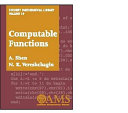Classical and Quantum Computation
2002년 1월 · American Mathematical Soc.
eBook
257
페이지
report검증되지 않은 평점과 리뷰입니다. 자세히 알아보기
eBook 정보
This book is an introduction to a new rapidly developing topic: the theory of quantum computing. It begins with the basics of classical theory of computation: Turing machines, Boolean circuits, parallel algorithms, probabilistic computation, NP-complete problems, and the idea of complexity of an algorithm. The second part of the book provides an exposition of quantum computation theory. It starts with the introduction of general quantum formalism (pure states, density matrices, andsuperoperators), universal gate sets and approximation theorems. Then the authors study various quantum computation algorithms: Grover's algorithm, Shor's factoring algorithm, and the Abelian hidden subgroup problem. In concluding sections, several related topics are discussed (parallel quantumcomputation, a quantum analog of NP-completeness, and quantum error-correcting codes). Rapid development of quantum computing started in 1994 with a stunning suggestion by Peter Shor to use quantum computation for factoring large numbers-an extremely difficult and time-consuming problem when using a conventional computer. Shor's result spawned a burst of activity in designing new algorithms and in attempting to actually build quantum computers. Currently, the progress is much more significantin the former: A sound theoretical basis of quantum computing is under development and many algorithms have been suggested. In this concise text, the authors provide solid foundations to the theory-in particular, a careful analysis of the quantum circuit model-and cover selected topics in depth. Someof the results have not appeared elsewhere while others improve on existing works. Included are a complete proof of the Solovay-Kitaev theorem with accurate algorithm complexity bounds, approximation of unitary operators by circuits of doubly logarithmic depth. Among other interesting topics are toric codes and their relation to the anyon approach to quantum computing. Prerequisites are very modest and include linear algebra, elements of group theory and probability, and the notion of a formalor an intuitive algorithm. This text is suitable for a course in quantum computation for graduate students in mathematics, physics, or computer science. More than 100 problems (most of them with complete solutions) and an appendix summarizing the necessary results are a very useful addition to thebook. It is available in both hardcover and softcover editions.
이 eBook 평가
의견을 알려주세요.
읽기 정보
스마트폰 및 태블릿
노트북 및 컴퓨터
컴퓨터의 웹브라우저를 사용하여 Google Play에서 구매한 오디오북을 들을 수 있습니다.
eReader 및 기타 기기
Kobo eReader 등의 eBook 리더기에서 읽으려면 파일을 다운로드하여 기기로 전송해야 합니다. 지원되는 eBook 리더기로 파일을 전송하려면 고객센터에서 자세한 안내를 따르세요.







